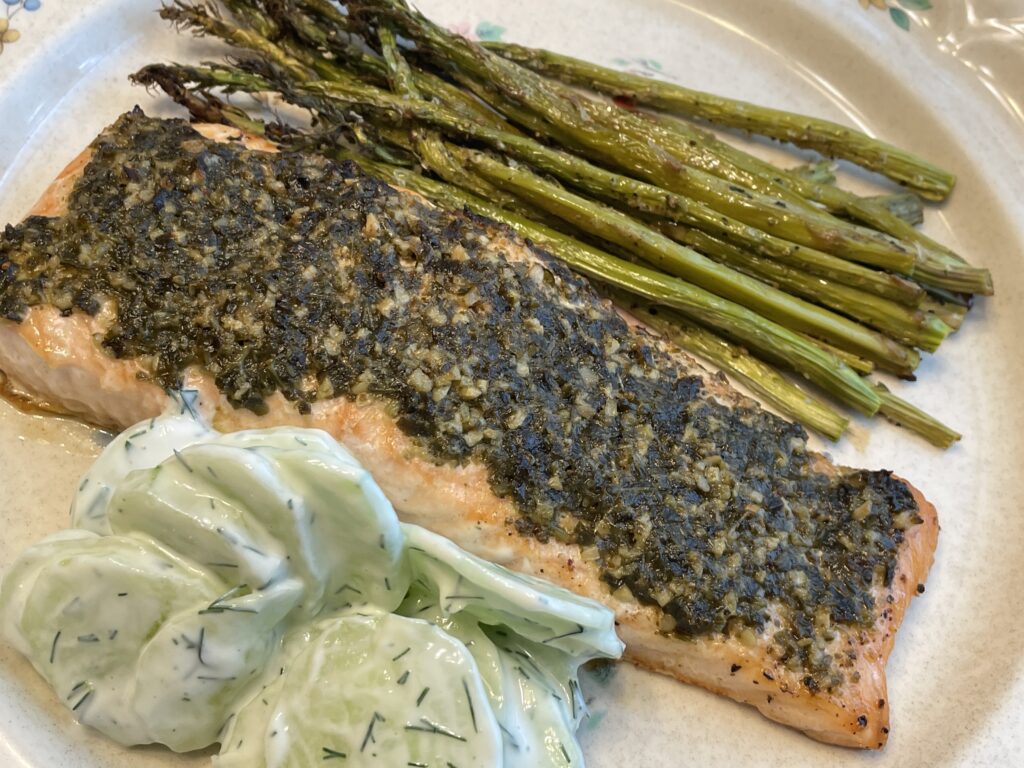In this blog post, we will share a delicious and nutritious recipe for Baked Pesto Salmon. Not only is this dish packed with flavor, but it also incorporates sustainable resources, making it an excellent choice for both your health and the environment. By using sustainably sourced salmon and homemade pesto, you can enjoy a guilt-free meal that supports both your well-being and the planet. Let’s dive into the recipe!
Ingredients
- 4 6-ounce salmon fillets, preferably sustainably sourced
- 2 cups fresh basil leaves
- 1/4 cup pine nuts
- 2 cloves garlic, minced
- 1/4 cup grated Parmesan cheese
- 1/4 cup extra-virgin olive oil
- Salt and pepper to taste
- Cooking spray
Preparation Steps
- Preheat the oven to 400°F (200°C). Line a baking sheet with foil or parchment paper or lightly grease it with cooking spray
- Prepare the homemade pesto. In a food processor or blender, combine the basil leaves, pine nuts, minced garlic, grated Parmesan cheese, salt, and pepper. Pulse until the ingredients are well blended.
- Slowly drizzle in the olive oil while the food processor or blender is running, until the mixture forms a smooth and creamy consistency. Set the pesto aside.
- Place the salmon fillets on the prepared baking sheet, skin side down. Season the fillets with salt and pepper.
- Spoon a generous amount of homemade pesto over each salmon fillet, spreading it evenly to cover the surface.
- Bake the salmon in the preheated oven for approximately 12-14 minutes, or until the fish is cooked through and flakes easily with a fork. Cooking time may vary depending on the thickness of the fillets, so keep an eye on them. We like ours medium, almost like sushi.
- Once the salmon is cooked, remove it from the oven and let it rest for a few minutes.
- Serve the Baked Pesto Salmon hot, garnished with fresh basil leaves and lemon wedges for squeezing over the fish. You can also pair it with a side of steamed vegetables such as asparagus and/or a crisp salad for a well-rounded meal.
Sustainable Tips:
1. Choose sustainably sourced salmon: Look for salmon that is labeled as sustainably caught or farmed, such as wild-caught Alaskan salmon or salmon certified by the Marine Stewardship Council (MSC). These options help support responsible fishing practices and protect marine ecosystems.
2. Utilize locally sourced ingredients: When possible, purchase basil and other fresh ingredients from local farmers or grow your own herbs at home. This reduces the carbon footprint associated with long-distance transportation and supports local agriculture. Or better yet, grow your own basil like we do in our back yard.
3. Minimize food waste: Use all parts of the ingredients when cooking. For instance, save any leftover basil stems to infuse in oils or stocks, and use the salmon skin to make crispy salmon skin chips as a tasty snack.
4. Opt for reusable or recyclable packaging: When buying pre-packaged ingredients, choose brands that use sustainable packaging materials. Look for recyclable, compostable, or reusable packaging options to minimize waste.
By making simple choices such as using sustainably sourced salmon and homemade pesto, we can create delicious meals that are good for our health and the environment. This Baked Pesto Salmon recipe is a testament to how sustainable cooking can be both enjoyable and flavorful. Give it a try and savor the taste of a dish that supports your well-being and the planet we call home. Enjoy!












